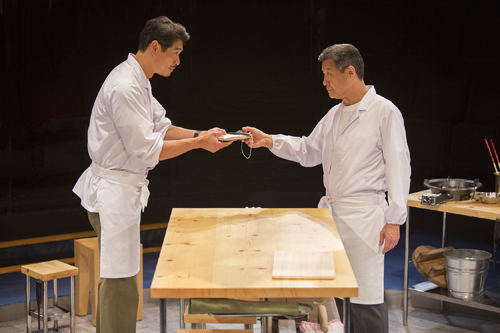
By Eric George Tauber

SAN DIEGO — Several years ago, my brother Matthew sent me a link to some YouTube videos featuring a production of Fiddler on the Roof done in Japanese. It seemed strange at first. But as an ESL teacher, I’ve come to appreciate various world cultures. In the Far East, the tug of war between tradition and change is particularly profound. Tokyo Fish Story, now playing at the Old Globe, is one such tale in the ongoing struggle.
Welcome to Sushi Koji, a traditional sushi bar in downtown Tokyo. James Saito plays Koji -aka “Master Shimada”- an old soul who takes great pride in his craft, waxing poetic about the need for fish to “really live” before it can be served.
Enter corporate competition: “I Am Sushi.” the place across the street serves apps and dessert, like a Japanese Applebee’s, and the line is around the block. His son, Taka, tries to persuade his father to be a little more yielding in the interest of business. But Master Shimada won’t hear of it, declaring with finality, “I don’t serve Happy Meals!”
The store is manned by two apprentices. Raymond Lee is lively and likable as Nobu, a young man enamored with hip-hop culture. He bows deferentially to Master Shimada, but his soul is busting other moves.
The tall and handsome Tim Chiou plays Taka, Koji’s son. At thirty-nine, he’s still an “apprentice.” Unlike the talkative and inquisitive Nobu, Taka plays his cards close to the chest, particularly when it comes to his year in America. Taka’s unique artistry with sushi could save the restaurant, but it could also hurt his father’s feelings.
When they fire a lazy rascal, they get two applicants, Ama, a hardworking young woman who knows the business, and Yuji, a high-strung nervous klutz. He’s not the sort you want around food and sharp objects, but he provides some much needed comic relief. And women and sushi aren’t “traditional.”
Hats off to the Old Globe for putting together a tight ensemble. Jon Norman Schneider really had to be on his toes with multiple costume changes, morphing into multiple characters. Tina Chilip was brash and edgy as Ama, yet quietly mysterious as the woman in blue who haunts Koji’s dreams.
Kudos to the crackerjack techies in the booth who had to time sound and light cues with flicks of fingers in the air. That tech rehearsal must have been a mighty long one because they didn’t miss a beat.
Kimber Lee’s Tokyo Fish Story isn’t just a Japanese tale. It’s about taking pride in your craft and coming into your own. Like Fiddler and Yentl, it’s about the tug of war between tradition and change. Ultimately, tradition and change must reconcile for either to have any meaning.
*
Tauber is a freelance writer specializing in coverage of the arts. He may be contacted via eric.tauber@sdjewishworld.com. Comments intended for publication in the space below MUST be accompanied by the letter writer’s first and last name and by his/ her city and state of residence (city and country for those outside the United States.)